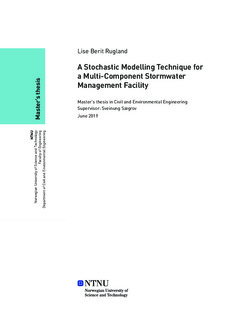| dc.contributor.advisor | Sægrov, Sveinung | |
| dc.contributor.author | Rugland, Lise Berit | |
| dc.date.accessioned | 2019-10-08T14:02:47Z | |
| dc.date.available | 2019-10-08T14:02:47Z | |
| dc.date.issued | 2019 | |
| dc.identifier.uri | http://hdl.handle.net/11250/2621019 | |
| dc.description.abstract | Formålet med denne oppgaven er å teste applikasjonen av en hendelses-basert stokastisk modell for et fler-komponent overvannshåndterings system i Sørvest-Norge. Området har både infiltrasjonsflater og konvensjonelle komponenter. Triangulære hydrografer ble generert basert på en probabilistisk regn-til-avrenning modell og en estimert konsentrasjonstid. Hydrografene ble brukt som input til en kaskade av magasinrutinger. Magasinene er kummer med åpen bunn, hvor tilgjengelig volum er diktert av grunnvannstand. Startvolumet er definert av sannsynlighetsfordelingen for grunnvannstand, og implementert i modellen som en stokastisk variabel. Til slutt, ble sannsynlighetsfordelinger av maks utløp fra alle kummer beregnet. Resultatene fra casestudiet er diskutert i kontekst av modell oppsettet og parametersettingen av input variabler. Artikkelen foreslår tre hovedbegrensninger mot implementeringen av en stokastisk metode for et fler-komponent overvannshåndterings system: Modellene er ofte stedsspesifikke; den beregningsmessige effektivitet blir redusert når systemet har mange komponenter; og fordelene med resultat formatet fra en stokastisk modell er begrenset når systemet fungerer optimalt. Funnene i dette studiet påpeker nyttige forbehold som bør tas når man velger modelleringsteknikk for komplekse avrenningssystemer. Kombinering av konvensjonelle dreneringssystemer og lokal overvannsdisponering kommer til å bli mer vanlig i kommende år. Derfor er det av høy interesse å utforske forbedrede og mer effektive modelleringsalternativer for bruk i ingeniør praksis. | |
| dc.description.abstract | This paper aims to test the application of an event-based stochastic model for a multicomponent stormwater management facility located in the southwest of Norway. The facility contains both infiltration surfaces and conventional components. Triangular hydrographs are derived using a probabilistic rainfall-runoff model and an estimated time of concentration. The hydrographs are used as input to a cascade of storage-indication reservoir routings. Openbottomed manholes are considered to be the reservoirs, for which the available storage level is dictated by the groundwater level. Initial storage level is defined by the probability distribution of the groundwater data and implemented in the model as a stochastic variable. Finally, probability distributions of peak discharge from all manholes are derived. The results of the case study are discussed in context of the model setup and parameterization of input variables. This paper suggests three main limitations to the implementation of a stochastic approach for multi-component drainage systems: Models are often highly site-specific; computational efficiency is reduced when the system contains several components; and the benefits of the output structure of a stochastic model are limited if the system is performing optimally. The findings in this study provides valuable considerations to have in mind when selecting a modelling technique for more complex drainage systems. Combining conventional and sustainable urban drainage systems is likely to become more common in following years. Therefore, it is of interest to explore improved and more efficient modelling alternatives for use in common engineering practice. | |
| dc.language | eng | |
| dc.publisher | NTNU | |
| dc.title | A Stochastic Modelling Technique for a Multi-Component Stormwater Management Facility | |
| dc.type | Bachelor thesis | |
